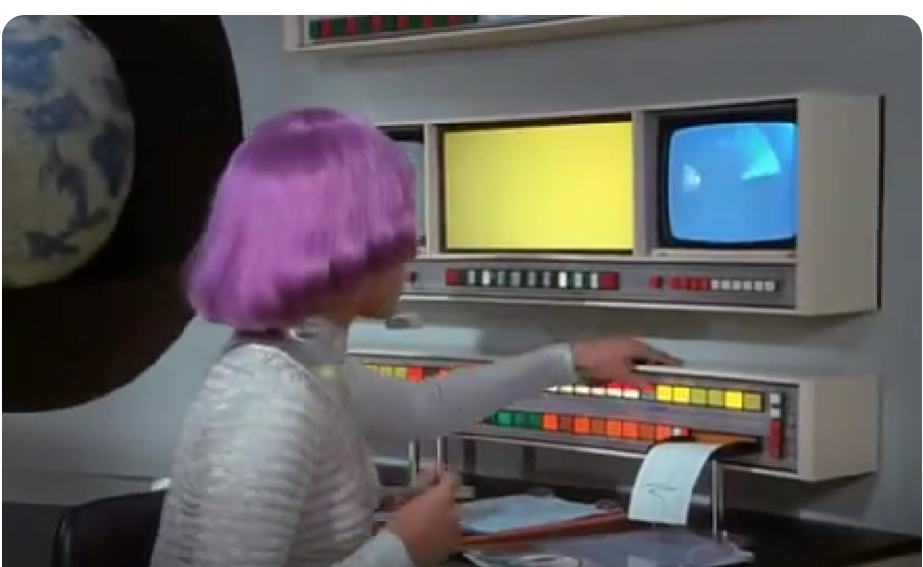Sometimes (often), 'good enough' is better than 'ideal'. Yes, it sounds paradoxical, and counterintuitive, but sometimes even the presumed ‘ideal’ is not, erm, ideal. Let me explain.
Screenshot from the UFO TV series
At one school I worked at as Head of ICT and Computing, there were three computer rooms. Two were fully equipped, and the third was full of old mini computers. It was like walking onto the half-constructed set of the UFO TV series, which I think had been made in the 1970s.
Nobody knew how to use them, and nobody wanted to know how to use them. I set up a mini computing museum with this and other old stuff, but there was nothing of any practical use.
I had a vision of a well-equipped set of computer suites, and so the ideal arrangement, from one point of view, would have been to extend the school network from the two already-networked computer rooms to the 1970s throwback room.
Terry having visions
However, that would have been extremely expensive and, frankly, not even ideal. Tnetwork was simply not fast enough to run Windows programs. For example, Word for Windows, as it was called back then, literally took half an hour to load if more than half a dozen people were using it at the same time. Once it had loaded, you would type a word and see it magically appear on the screen — at least ten seconds later. Useless. Fortunately, there were some excellent non-Windows programs on the system, and the local authority had created and given every school a copy of a brilliant menu system, a kind of graphic user interface, so the computers were perfectly usable, both for curriculum and admin purposes, just not cutting edge.
Having already assured the headteacher that, should he ever find himself in the position of having a huge sum of money to get rid of quickly, I was his man. Or even a small sum of money. I had a kind of shopping list in my head, which meant that I always knew what to buy for different amounts of money.
For example, if the headteacher gave me £10, I could buy some spare inkn cartridges with that. A ‘gift’ of £100 would be enough for an extra piece of software with a network licence, while that of £1000 would be enough to buy a new computer with pre-installed software.
One day the headteacher approached me and asked if I’d like £9000 for computing equipment. Of course I said “yes”, even though that would be enough only for 9 or 10 computers, which wouldn’t be enough for a teacher wanting all the pupils to work on the computers (in pairs) at the same time.
(Mind you, that wouldn’t have been as problematic as I’ve made out. In my subsequent school I set up a room — more of a cupboard really — with 8 computers and a printer solely for staff use, and it was almost never unoccupied. Also, I set up a computer room with desks and easy chairs and a couple of coffee tables, as well as computers, for pupil use, which facilitated several kinds of activities during a lesson.)
However, then came the sting in the tale. The conversation went something like this:
Headteacher: You can only spend the money on hardware, not software.
Me: So what am I supposed to do with the computers then if I don’t have anything to run on them?
Headteacher: That’s something you’ll have to work out for yourself, I’m afraid. The money is only for hardware. Would you still like the money or not?
I accepted the offer, indubitably — and the challenge.
As it happens, things worked out really well, much better, in fact, than if I’d had enough money to buy a whole suite of the existing network commputers. I decided to buy a class set of Atari computers. The Atari was not just a games computer. It has a graphical user interface, and some excellent office applications, as well as free software for curriculum use.
I negotiated with a company to sell me 15 computers with software pre-installed, plus a printer. All for around £9000.
A History lesson in the Atari Room, by Terry Freedman. The students were doing research into the JFK assassination using free software.
There were downsides: they were not networked, and the operating system and other software were not the same as the networked computers. But the Ataris were fast and easy to use. The Atari Room, as I called it, was hardly ever devoid of people.
Moreover, a manual I wrote for the word processing application was good enough that many people, even those who had no connection with the school, wanted to buy it. The proceeds were enough to fund more hardware.
Overall, the outcome was far better than if I’d been given enough funding for simply an extension of the existing network. A prime example of where doing the best one can with limited resources, which means going for ‘good enough’ is far better than the (perceived) ideal.



